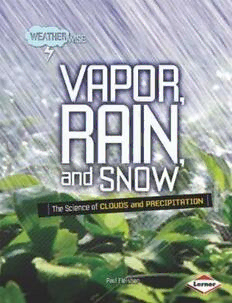
Vapor, Rain, and Snow: The Science of Clouds and Precipitation (Weatherwise) PDF
Preview Vapor, Rain, and Snow: The Science of Clouds and Precipitation (Weatherwise)
THIS PAGE INTENTIONALLY LEFT BLANK S LERNER PUBLICATIONS COMPANY · MINNEAPOLIS Text copyright © 2011 by Paul Fleisher All rights reserved. International copyright secured. No part of this book may be reproduced, stored in a retrieval system, or transmitted in any form or by any means—electronic, mechanical, photocopying, recording, or otherwise—without the prior written permission of Lerner Publishing Group, Inc., except for the inclusion of brief quotations in an acknowledged review. Lerner Publications Company A division of Lerner Publishing Group, Inc. 241 First Avenue North Minneapolis, MN 55401 U.S.A. Website address: www.lernerbooks.com Library of Congress Cataloging-in-Publication Data Fleisher, Paul. Vapor, rain, and snow : the science of clouds and precipitation / by Paul Fleisher. p. cm. — (Weatherwise) Includes bibliographical references and index. ISBN 978–0–8225–7534–4 (lib. bdg. : alk. paper) 1. Clouds—Juvenile literature. 2. Precipitation (Meteorology)—Juvenile literature. I. Title. QC921.35.F555 2011 551.57’6—dc22 2009041720 Manufactured in the United States of America 1 – PC – 7/15/10 eISBN: 978-0-7613-6328-6 | the science of the ATMOSPHERE | | CONTENTS | 4 INTROdUCTION 6 ChAPTER ONE Water in the Air 15 ChAPTER TWO Clouds 26 ChAPTER ThREE Precipitation 39 ChAPTER FOUR Rainbows, halos, and Sun dogs 44 GLOSSARY 45 SELECTEd BIBLIOGRAPhY 45 FOR FURThER REAdING 46 WEBSITES 47 INdEx | INTROdUCTION | W eather is what happens in the air around us. But a lot of weather is really about water. When we think about weather, we think about rain or snow. We think about clouds and humidity. Each of those involves a form of water. Air is a mixture of clear, colorless gases. Water vapor is one of those gases. (It is the gas form of water.) The amount of water vapor in the air is always changing. On humid days, the air contains a lot of water vapor. When the air is dry, it holds very little water vapor. 4 Water typically falls from the sky in the form of rain or snow. It eventually returns to the sky when it turns into water vapor. Meteorology is the science of weather. For meteorologists to understand weather, they have to know what happens to water in the air. They have to be able to measure the amount of water in the air. They have to recognize different kinds of clouds and the weather these clouds bring with them. They have to know about different types of precipitation, such as mist, rain, sleet, and snow. And they have to know how water vapor carries the sun’s energy from one part of the atmosphere to another. Introduction 5 | ChAPTER ONE | WATER IN ThE AIR E arth has only a limited amount of water. That water is recycled again and again. Water vapor in the air comes from oceans, from the land, and even from the leaves of plants. Water falls back to the ground as rain or snow. Plants take in some of the water. A small amount is frozen into glaciers. Some water flows to streams, lakes, and rivers. It eventually flows back to the oceans, where it may become vapor again. This process is called the water cycle. Water moves through the water cycle in three different states. Ice is solid water. So are frost and snow. Rain and dew are liquid water. Tiny droplets of liquid water make up clouds. Water vapor is an invisible gas. 6 Vapor, raIn, and SnoW The Water condensation Cycle (gas to liquid) precipitation (liquid and solid) evaporation (liquid to gas) Water takes all three forms in the atmosphere, the layer of air that FASCINATING surrounds Earth. FACT: Water changes back and forth between states. When water changes from a liquid How much water is in to a solid, it freezes. When ice changes the atmosphere at any from solid to liquid, it melts. When water one time? Enough to changes from liquid to gas, it evaporates. cover the whole Earth with water about 1 And it condenses when it changes from gas inch (2.5 centimeters) to liquid. deep. Water in the air 7 Water evaporates from the surface of a calm lake. In the cooler air above the lake, the water condenses into fog. A lot of energy is needed for water to change from solid to liquid. Water needs even more energy to change from liquid to gas. That energy comes from the sun. Evaporating water carries the sun’s energy with it in the form of heat. Whatever area water evaporates from gets cooler. When water evaporates from our skin, we no longer feel as hot. When water condenses, it releases its energy. The air around it gets warmer. This energy helps clouds form. It fuels powerful storms. As a result, evaporation and condensation transfer huge amounts of energy into the atmosphere. SUBLIMATION ANd dEPOSITION Sometimes water changes directly from a solid to a gas. On cold, dry days, snow slowly disappears without melting. The snow changes into 8 Vapor, raIn, and SnoW
